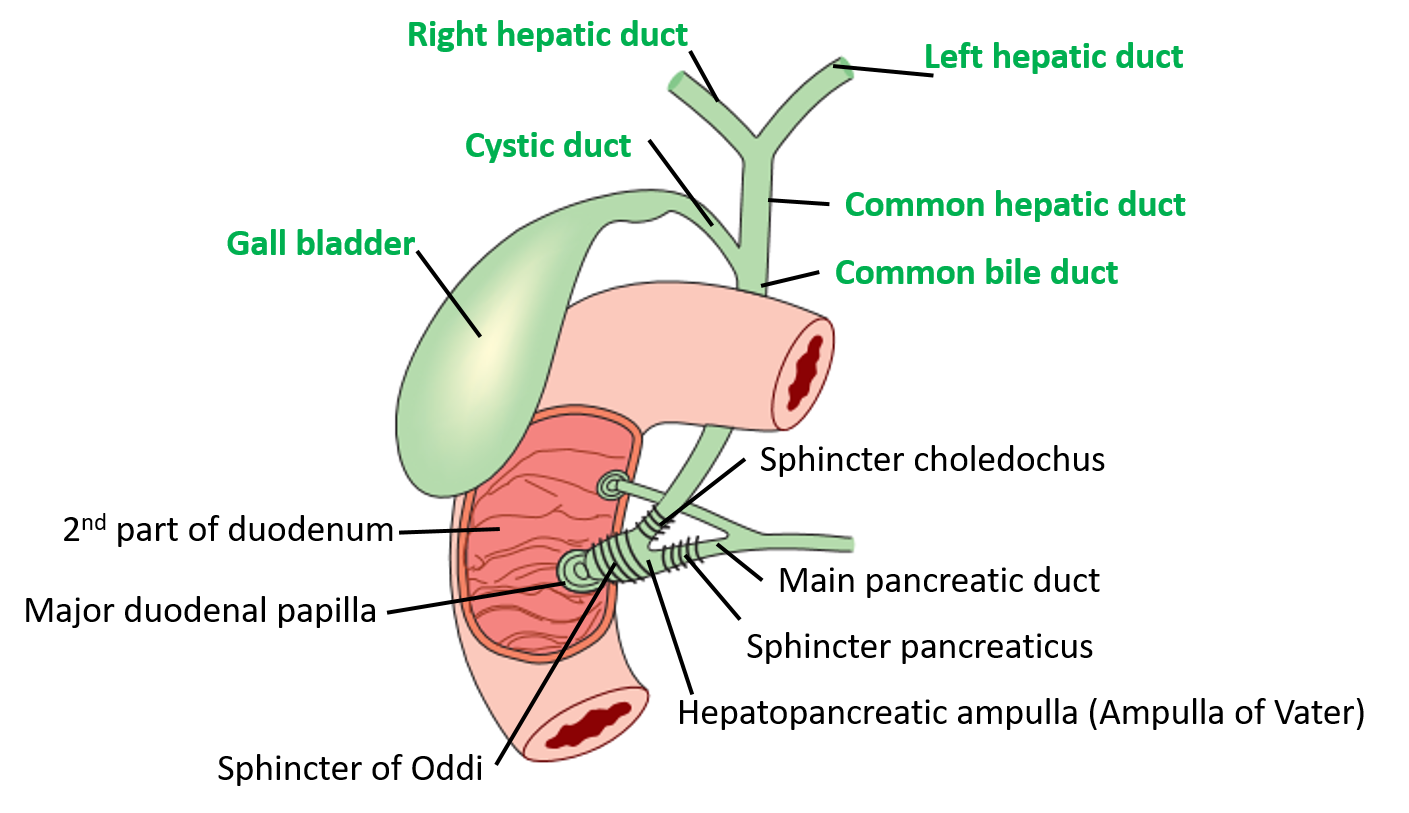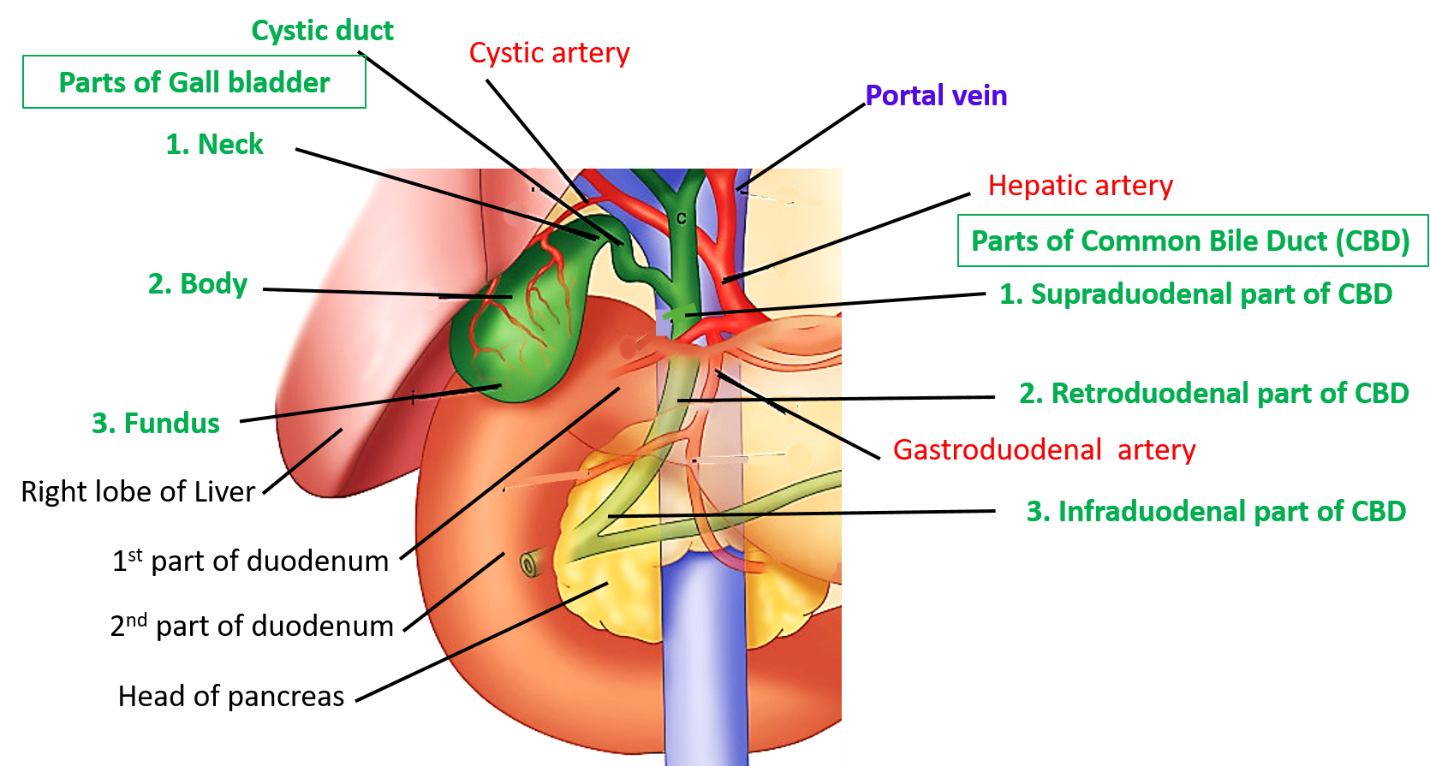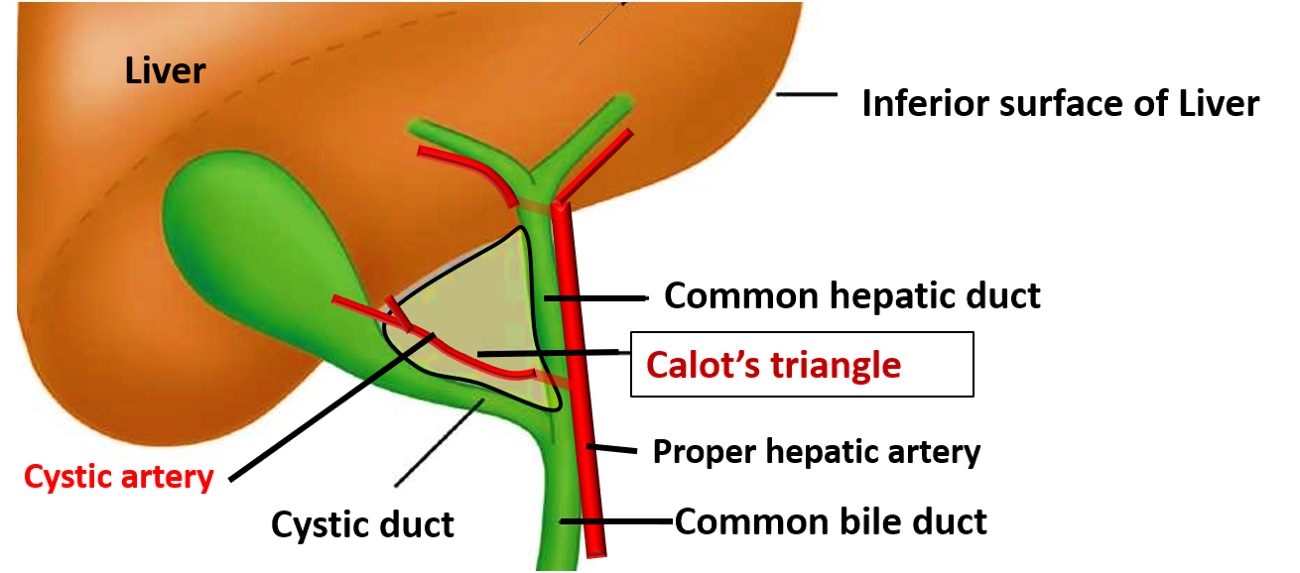Enumerate the components of extrahepatic biliary apparatus.
The components of extrahepatic biliary apparatus are:
- Right and left hepatic ducts
- Common hepatic duct
- Gall bladder and cystic duct
- Common bile duct

Describe the components of extrahepatic biliary apparatus.
Right and left hepatic ducts
- Right and left hepatic ducts carry bile from the right and left physiological lobes of liver respectively.
- They emerge at the porta hepatis anterior to branches of portal vein and hepatic artery.
Common hepatic duct
- It is formed by union of right and left hepatic ducts near the right end of porta hepatis.
- It is ~3cm. in length and is joined by cystic duct to form common bile duct (CBD).
Gall bladder
- It is a pear shaped fibromuscular sac that stores and concentrates bile.
- It lies in the gall bladder fossa on the inferior surface of right lobe of liver
- Functions of gallbladder:
- It stores bile.
- It absorbs water and electrolytes and thus concentrates the bile.
- Measurements:
- 7-10 cm
- in its widest part.
- 30-50 ml.
- Parts: It has three parts
- Fundus: Is the lower free
- Is the expanded part which projects beyond the inferior border of liver.
- It is covered by peritoneum on all the sides.
- Is related to anterior abdominal wall anteriorly and transverse colon posteriorly.
- Body:
- It is the major part of gall bladder extending from fundus to neck.
- Superior surface is adherent to liver (gall bladder fossa) and is devoid of peritoneum.
- Inferior surface is covered by peritoneum and is related to transverse colon and 1st and 2nd part of duodenum.
- Neck:
- It is the upper narrow part which end in cystic duct.
- The mucous membrane of neck has fold arranged spirally
- The posteromedial wall of neck may be dilated outwards to form a pouch called Hartmann’s pouch. Gall stones may lodge in this pouch.
- It is related inferiorly to 1st part of duodenum.
- Fundus: Is the lower free
- Arterial supply of gall bladder: It is supplied by cystic branch of right hepatic artery which passes through the Calot’s triangle.
Cystic duct
- It begins at the neck of gall bladder and joins common hepatic duct to form CBD.
- It is 3-4 cm long.
- The mucous membrane has spirally arranged 5-12 crescentic folds (valve of Heister).
Common bile duct
- It is approximately 8 cm long and 6 mm wide.
- It is formed by union of common hepatic duct and cystic duct.
- It is divided into 4 parts according to its course:
- Supraduodenal: above the first part of duodenum, runs in the free margin of lesser omentum.
- Retroduodenal: Behind the first part of duodenum.
- Infraduodenal: below the first part of duodenum and behind the head of pancreas.
- Intraduodenal: Passing through the wall of duodenum along with the main pancreatic duct.
- Within the wall of the duodenum it unites with the maon pancreatic duct to form hepatopancreatic ampulla (ampulla of Vater).
- The distal end of the ampulla opens at the summit of major duodenal papilla, present along the posteromedial wall of duodenum, 8-10 cm. distal to the pylorus.
- The sphincter present around the distal end of CBD is called sphincter choledochus.
- The sphincter around the hepatopancreatic ampulla is called Sphincter of Oddi.

Relations of CBD
Part of duodenum Anterior Relations Posterior relations Left relations Supraduodenal Liver Duodenum Head of pancreas Retroduodenal Portal vein Inferior vena cava Inferior vena cava Infraduodenal Hepatic artery Gastroduodenal artery Posterior branch of supraduodenal artery
Applied Aspect
Calot’s Triangle/ Cystohepatic triangle
Calot’s triangle is an important landmark used for locating cystic artery (lies in the Calot’s triangle) during laparoscopic cholecystectomy. The triangle also contains a lymph node (Lund’s node) which is frequently enlarged due to inflammation of the gallbladder (e.g. cholecystitis) or the biliary tract (e.g.cholangitis). It and may be removed along with the gallbladder during cholecystectomy. The boundaries of the triangle are:
- Superiorly: Inferior surface of liver
- Left: Common hepatic duct
- Right: Cystic duct

Referred pain in cholecystitis
It is referred to:
- Skin over the tip of the right shoulder: The inflammation of the gall bladder may cause irritation of the subdiaphragmatic parietal peritoneum which is supplied by phrenic nerve (root value -C3,4,5) and the pain may be referred to the skin over the tip of the right shoulder as it is supplied by supraclavicular nerve (C3, C4).
- Epigastrium and inferior angle of right scapula: Gall bladder receives sympathetic innervation from T7-T9 spinal segments. Skin over epigastric region also gets somatic innervation from the same spinal segments and the skin at the inferior angle of scapula is supplied by T7 spinal segment.
Murphy’s sign
A positive Murphy’s sign is seen in acute cholecystitis. It is elicited by firmly placing a hand at the costal margin in the right upper abdominal quadrant and asking the patient to inspire deeply. If the gallbladder is inflamed, the patient will experience pain and catch their breath as the gallbladder descends and contacts the palpating hand.
Biliary dyskinesia
Musculature of gall bladder wall and sphincter of Oddi (controls the flow of bile and pancreatic juice into the second part of the duodenum) have reciprocal innervation i.e. if gall bladder contracts, sphincter relaxes. If this mechanism is disrupted it is called biliary dyskinesia.

The posterior relation of supraduodenum part is portal vein and to its left lies the hepatic artery and similarly the other relation are also not correct as they should be .
Very nice class
Thank you mam it’s very useful
It’s very good